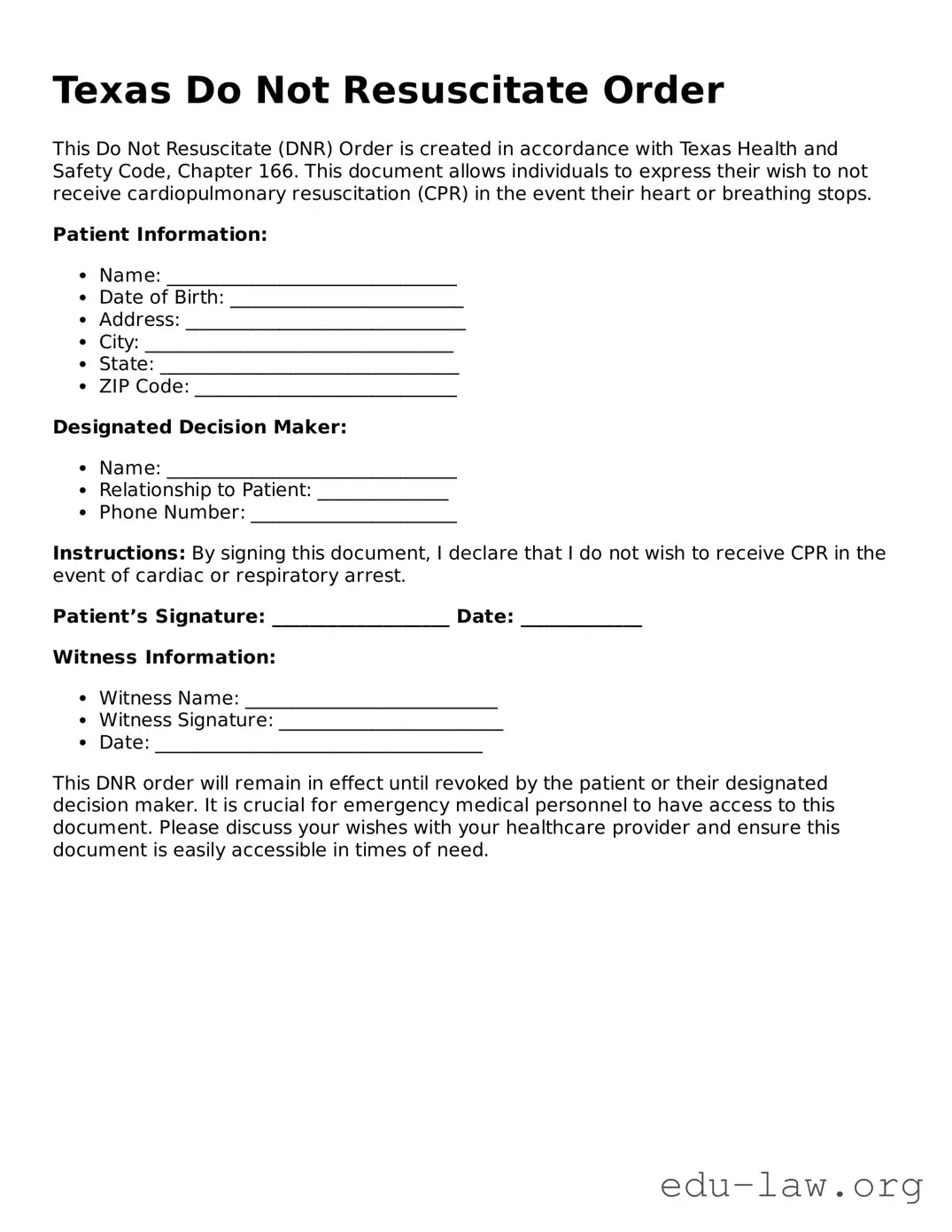The Texas Do Not Resuscitate Order (DNR) form is often compared to the Living Will. Both documents serve the purpose of outlining an individual’s preferences regarding medical treatments in the event of incapacitation. A Living Will allows individuals to specify their desires regarding various medical interventions, such as life-sustaining treatments, whereas a DNR specifically addresses the refusal of resuscitation efforts during cardiac or respiratory arrest. Both documents are crucial for ensuring that an individual's health care wishes are respected when they are unable to communicate them directly.
Another document similar to the DNR is the Medical Power of Attorney. This legal document designates a trusted individual to make medical decisions on behalf of someone who is unable to do so. Like a DNR, it focuses on medical care and treatment preferences. However, while a DNR specifically addresses resuscitation, the Medical Power of Attorney allows for broader decision-making authority regarding all aspects of medical treatment and care, encompassing a range of health situations.
The Physician Orders for Life-Sustaining Treatment (POLST) form also shares similarities with the Texas DNR. POLST is designed for individuals with serious health conditions and offers clear medical orders that healthcare providers must follow. While the DNR form indicates a desire not to receive resuscitation, the POLST form can cover a wider array of medical interventions, including preferences for feeding tubes, antibiotics, and other life-sustaining treatments.
The Advance Directive is another related document. An Advance Directive encompasses both a Living Will and a Medical Power of Attorney, providing a comprehensive overview of an individual's medical care wishes. While a DNR focuses specifically on resuscitation, an Advance Directive can address a broader range of medical scenarios, ensuring that an individual’s healthcare wishes are documented and followed.
Patient Characteristics form also bears similarity to the DNR process. It typically gathers information about a patient’s medical history and current health status. While it does not set forth specific treatment decisions, it aids healthcare providers in making informed choices about appropriate treatments, including considerations around resuscitation efforts. This document helps ensure that individual health details are taken into account by medical professionals.
In some cases, a Healthcare Proxy serves similar purposes. This document appoints someone to make health care decisions based on a person's wishes. While it does not specifically address resuscitation requests, it plays a critical role in providing guidance concerning a person's overall healthcare preferences. The Healthcare Proxy can complement the information provided in a DNR, ensuring that the appointed individual is aware of the person's wishes regarding resuscitation.
The Comfort Care Order is also comparable. It prioritizes comfort and symptom management over aggressive medical treatments. While a DNR specifically forbids resuscitation, a Comfort Care Order emphasizes the importance of providing comfort measures rather than invasive procedures. This approach aligns with the underlying goals of the DNR, focusing on quality of life as opposed to mere prolongation of life through medical interventions.
Similarly, the Do Not Intubate Order (DNI) is intimately related to the DNR. This order specifies that a patient should not be intubated to assist with breathing if they experience respiratory failure. While the DNR deals specifically with cardiac arrest situations, the DNI strengthens an individual’s wish to avoid invasive procedures when unable to breathe adequately, thus aligning closely in terms of end-of-life care preferences.
Lastly, the Burial Instructions document also has relevance. Although significantly different in nature, it can provide insight into an individual’s overall wishes regarding their healthcare and afterlife choices. It does not directly address medical interventions or resuscitation, but having such instructions helps family members and healthcare providers understand the person's values and preferences during critical health moments.
